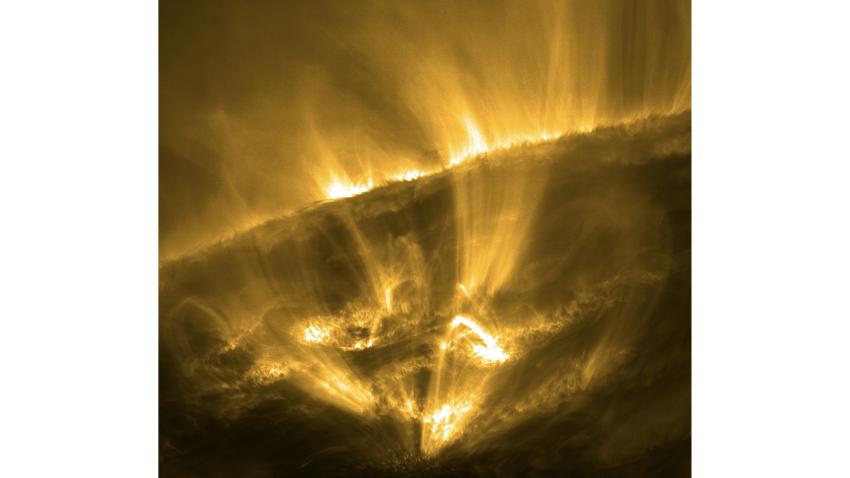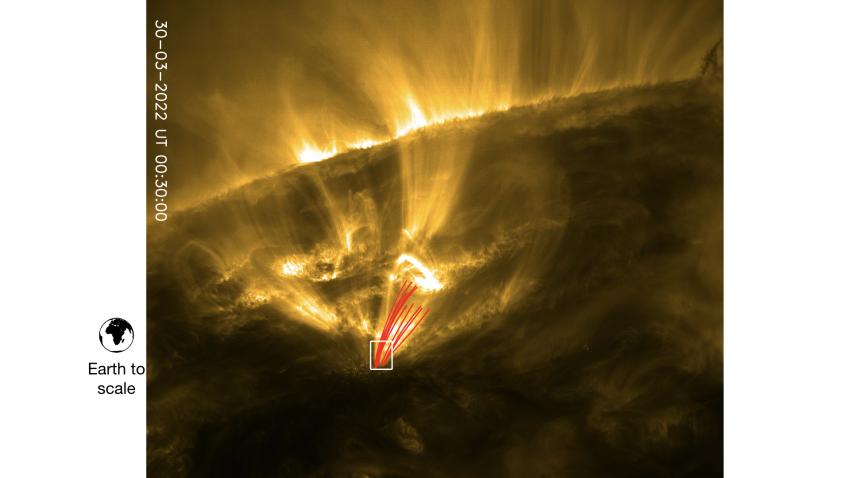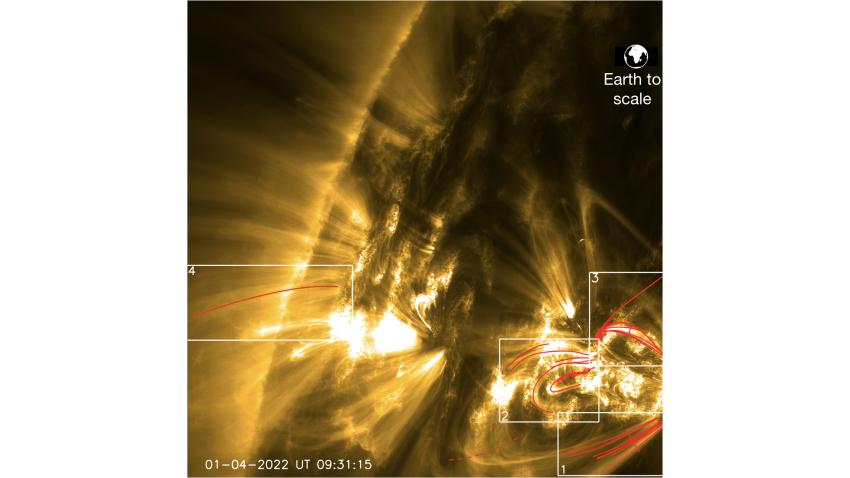A team of astronomers from several European institutions led by Northumbria University in Newcastle has discovered ‘shooting stars’ on the Sun. Observations from the European Space Agency’s Solar Orbiter (SolO) have revealed never-before-seen ‘falling star’-type phenomena or meteor-like fireballs occurring within the spectacular plasma displays known as coronal rain. The work will be presented this week at the National Astronomy Meeting (NAM 2023) by lead author Patrick Antolin, Assistant Professor at Northumbria University.
Although not real water, coronal rain is a condensation process in which some of the Sun’s fiery material clumps together due to sudden, localised temperature drops. The corona, which is the outermost part of the Sun’s atmosphere, is formed of gas at million-degree temperatures, and quick drops in temperature produce super-dense clumps of plasma that reach 250 kilometres wide. These fiery balls plummet back down towards the Sun as gravity pulls them in at over 100 kilometres per second.
Credit: Patrick Antolin. Background image: ESA/Solar Orbiter EUI/HRI
The research will be published in a special issue of Astronomy & Astrophysics dedicated to SolO’s first close perihelion to the Sun. In spring 2022, SolO cruised super close to the sun at a distance of only 49 million kilometres – a third of the distance between the Earth and the Sun – allowing the best spatial resolution ever obtained of the solar corona.
Along with the first super-high-resolution images of the coronal rain clumps, SolO observed the heating and compression of gas immediately underneath them. The resulting spike in intensity below the clumps indicates that the gas is heated up to a million degrees, which lasts for a few minutes as they fall.
On Earth, ‘shooting stars’ happen when meteoroids, or objects in space that range in size from dust grains to small asteroids, enter our atmosphere at high speeds and burn up. Only some meteors make it to the ground without disintegrating and those that do can produce huge craters. But the Sun’s corona is thin and low in density and does not strip much material off the clumps, so scientists think most of the ‘shooting stars’ make it to the solar surface intact. Their impacts have never been observed until now and SolO’s observations have revealed that this process can produce a brief, strong brightening with an upward surge of material and shock waves that reheat the gas above.
‘Shooting stars’ and meteors in Earth’s atmosphere are characterised by a trace behind the meteor’s path, formed when heated material underneath strips off parts of the object – a process called ablation. The same happens to comets orbiting the Sun. However, ablation does not occur in the solar corona because of its magnetic field. Instead, falling gas is partially ionised and follows the magnetic field lines, which act as giant tubes that funnel the gas. The compression and heat underneath prevents the clumps from producing tails and makes the phenomenon much harder to capture on the Sun.
The project’s lead author, Patrick Antolin, says: “The inner solar corona is so hot we may never be able to probe it in situ with a spacecraft. However, SolO orbits close enough to the Sun that it can detect small-scale phenomena occurring within the corona, such as the effect of the rain on the corona, allowing us a precious indirect probe of the coronal environment that is crucial to understanding its composition and thermodynamics. Just detecting coronal rain is a huge step forward for solar physics because it gives us important clues about the major solar mysteries, such as how it is heated to millions of degrees.”
“If humans were alien beings capable of living on the Sun’s surface, we would constantly be rewarded with amazing views of shooting stars,” jokes Antolin, “but we would need to watch out for our heads!”
These SolO observations have also confirmed earlier research which showed that coronal rain is far more pervasive than previously thought.
Media Contacts
Megan Eaves
Royal Astronomical Society
press@ras.ac.uk
Gurjeet Kahlon
Royal Astronomical Society
Mob: +44 (0)7802 877 700
press@ras.ac.uk
Dr Robert Massey
Royal Astronomical Society
Mob: +44 (0)7802 877 699
press@ras.ac.uk
Science Contacts
Dr Patrick Antolin
Northumbria University
PATRICK.ANTOLIN@northumbria.ac.uk
Dr Frédéric Auchère
Université Paris-Saclay, CNRS, Institut d’Astrophysique Spatiale
frederic.auchere@universite-paris-saclay.fr
Dr D. Berghmans, Royal Observatory of Belgium
david.berghmans@oma.be
Further information
Patrick Antolin acknowledges funding from STFC Ernest Rutherford Fellowship No. ST/R004285/2.
The research appears in: https://doi.org/10.1051/0004-6361/202346016
https://ui.adsabs.harvard.edu/abs/2023arXiv230511691A/abstract
Notes for editors
The NAM 2023 conference is principally sponsored by the Royal Astronomical Society (RAS), the Science and Technology Facilities Council (STFC) and Cardiff University.
About the Royal Astronomical Society
The Royal Astronomical Society (RAS, https://ras.ac.uk), founded in 1820, encourages and promotes the study of astronomy, solar-system science, geophysics and closely related branches of science. The RAS organises scientific meetings, publishes international research and review journals, recognises outstanding achievements by the award of medals and prizes, maintains an extensive library, supports education through grants and outreach activities and represents UK astronomy nationally and internationally. Its more than 4,000 members (Fellows), a third based overseas, include scientific researchers in universities, observatories and laboratories as well as historians of astronomy and others.
Follow the RAS on Twitter (https://twitter.com/royalastrosoc), Facebook (https://facebook.com/royalastrosoc), Instagram (https://instagram.com/royalastrosoc) and YouTube (https://www.youtube.com/channel/UCUZJ5FO9ayrmepOM4FHAASw)
About the Science and Technology Facilities Council
The Science and Technology Facilities Council (STFC) is part of UK Research and Innovation – the UK body which works in partnership with universities, research organisations, businesses, charities, and government to create the best possible environment for research and innovation to flourish. STFC funds and supports research in particle and nuclear physics, astronomy, gravitational research and astrophysics, and space science and also operates a network of five national laboratories, including the Rutherford Appleton Laboratory and the Daresbury Laboratory, as well as supporting UK research at a number of international research facilities including CERN, FERMILAB, the ESO telescopes in Chile and many more.
STFC's Astronomy and Space Science programme provides support for a wide range of facilities, research groups and individuals in order to investigate some of the highest priority questions in astrophysics, cosmology and solar system science. STFC's astronomy and space science programme is delivered through grant funding for research activities, and also through support of technical activities at STFC's UK Astronomy Technology Centre and RAL Space at the Rutherford Appleton Laboratory. STFC also supports UK astronomy through the international European Southern Observatory and the Square Kilometre Array Organisation.
Visit https://stfc.ukri.org/ for more information.
Follow STFC on Twitter: @STFC_Matters
About Cardiff University
Cardiff University is recognised in independent government assessments as one of Britain’s leading teaching and research universities and is a member of the Russell Group - the UK’s most research intensive universities. The 2021 Research Excellence Framework found 90% of the University’s research to be world-leading or internationally excellent. Among its academic staff are two Nobel Laureates, including the winner of the 2007 Nobel Prize for Medicine, Professor Sir Martin Evans. Founded by Royal Charter in 1883, today the University combines impressive modern facilities and a dynamic approach to teaching and research. The University’s breadth of expertise encompasses: the College of Arts, Humanities and Social Sciences; the College of Biomedical and Life Sciences; and the College of Physical Sciences and Engineering. Its University institutes bring together academics from a range of disciplines to tackle some of the challenges facing society, the economy, and the environment. More at www.cardiff.ac.uk




